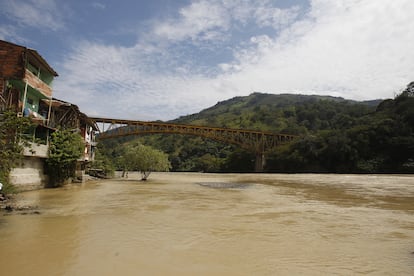The search for the disappeared submerged during construction of Colombia’s Ituango Dam
Underwater archeologists present methods for locating thousands of missing persons dumped in the Cauca River years ago


For decades, people living in the nine municipalities around the Ituango Dam in Antioquia (northwestern Colombia) have endured armed groups and the vagaries of the massive hydroelectricity project that will eventually supply 17% of Colombia’s energy needs. Ituango Dam changed the lives of thousands of local residents, even the dead ones.
Thousands of people who disappeared during the various armed conflicts that plagued the region are presumed to be buried somewhere under the muddy waters of the Cauca River, which was diverted in 2014 for dam construction. Now their relatives want to find them, and Colombia’s Special Jurisdiction for Peace (JEP) is the organization tasked with locating the remains of their loved ones. The JEP’s first task was to conduct underwater surveys in the areas flooded by the reservoir.
It’s an enormous challenge, but according to a report prepared for the JEP by Équitas, a Colombian forensic investigation organization, there are several methods for conducting the search. Because Colombian rivers were often used to surreptitiously dump dead bodies, massive underwater searches have been conducted before. Authorities believe that 9,000 corpses lie somewhere beneath the Canal del Dique, an artificial canal connecting Cartagena Bay to the Magdalena River in northern Colombia. The country hopes that both underwater recovery efforts will help it come to terms with the grim truth about its recent history.
The bodies of 2,094 missing persons from the municipalities of Briceño, Cáceres, Ituango, Nechí, Peque, Sabanalarga, Tarazá, Toledo and Valdivia are located somewhere in the vicinity of the Ituango Dam, according to information the JEP received from MOVICE, an organization of victims of state crimes. MOVICE requested government protection of 16 areas where missing persons are believed to be buried. Now the JEP will try to locate them underwater in areas upstream from the dam.
Forensic anthropologists and archaeologists from Équitas and the JEP’s investigative unit conducted an initial underwater archaeological survey on the banks of the Cauca River near the dam. By cross-referencing missing persons reports, judicial system databases, human rights violation data and individual sources, they identified 282 underwater sites where the remains of 131 missing persons are believed to be.
However, archaeologists say an underwater search is only feasible in three of these sites – Pescadero, Barbacoas and Orobajo. The lack of underwater visibility and an aquatic floating weed known as “buchón” that fouls boat engines further complicate the effort. Scuba divers are also unable to work in these areas.
In a recent public hearing, underwater archaeologist Carlos del Cairo said they first had to properly delimit the search area using data from before and after dam’s construction. They also used specialized software to demarcate what they call underwater anomalies (trees, walls, houses, etc.). One such anomaly is a large, egg-shaped rock that local farmers say marks a spot where missing persons were buried. The search team found the rock and identified a flat area where the graves could be. “This is how we reduce the level of uncertainty about sites where missing persons might be found,” said Del Cairo. Similarly, a survey of the now-submerged Barbacoas cemetery identified a wall where eight people are said to have been buried.
While this type of information is valuable, specialized machinery is still needed to conduct underwater excavations because of the impossibility of sending in divers. Two options were proposed: a gravity corer with a 20-foot tube to extract underwater soil and sediment samples; and a box corer, which uses a metal box instead of a tube for extracting the samples. “Once we dump the samples on the deck of our vessel, the material is examined by a forensic team that initiates a chain of custody,” said Équitas anthropologist Ana Carolina Guatame. “We are dealing with fragile material that was initially dry and then submerged in water. Now we’re bringing it back into a dry environment. We established excavation protocols in advance to avoid doing anything that could hamper the identification process.”
Do these technologies exist in Colombia? Have they ever been used to search for bodies? Will bones be broken or damaged during excavation? These were some of the many questions raised during the hearing by JEP magistrates Gustavo Salazar and Alejandro Ramelli, as well as by relatives of the victims and representatives from environmental protection organizations like Ríos Vivos.
The JEP also ordered investigations of remains held by the University of Antioquia’s osteology laboratory and others interred at the El Universal cemetery in Medellín, because at least 140 unidentified bodies found during dam construction were taken there. Dam builder Empresas Públicas de Medellín (EPM) and another company reportedly exhumed bodies from the Barbacoas, La Fortuna and Orobajo cemeteries and transferred them to Medellín. According to the JEP, EPM did not indicate the reasons for its decision to transfer the bodies.
Sign up for our weekly newsletter to get more English-language news coverage from EL PAÍS USA Edition
Tu suscripción se está usando en otro dispositivo
¿Quieres añadir otro usuario a tu suscripción?
Si continúas leyendo en este dispositivo, no se podrá leer en el otro.
FlechaTu suscripción se está usando en otro dispositivo y solo puedes acceder a EL PAÍS desde un dispositivo a la vez.
Si quieres compartir tu cuenta, cambia tu suscripción a la modalidad Premium, así podrás añadir otro usuario. Cada uno accederá con su propia cuenta de email, lo que os permitirá personalizar vuestra experiencia en EL PAÍS.
¿Tienes una suscripción de empresa? Accede aquí para contratar más cuentas.
En el caso de no saber quién está usando tu cuenta, te recomendamos cambiar tu contraseña aquí.
Si decides continuar compartiendo tu cuenta, este mensaje se mostrará en tu dispositivo y en el de la otra persona que está usando tu cuenta de forma indefinida, afectando a tu experiencia de lectura. Puedes consultar aquí los términos y condiciones de la suscripción digital.
More information
Archived In
Últimas noticias
Most viewed
- Oona Chaplin: ‘I told James Cameron that I was living in a treehouse and starting a permaculture project with a friend’
- Reinhard Genzel, Nobel laureate in physics: ‘One-minute videos will never give you the truth’
- Sinaloa Cartel war is taking its toll on Los Chapitos
- Why the price of coffee has skyrocketed: from Brazilian plantations to specialty coffee houses
- Chevy Chase, the beloved comedian who was a monster off camera: ‘Not everyone hated him, just the people who’ve worked with him’










































